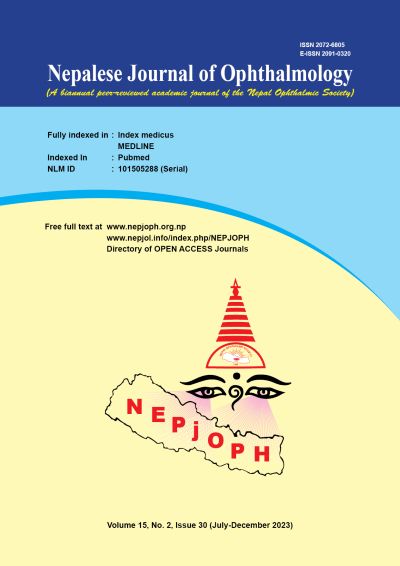Patterns of Macular Edema in Branch Retinal Vein Occlusion Diagnosed by Optical Coherence Tomography
DOI:
https://doi.org/10.3126/nepjoph.v15i2.29763Keywords:
Branch retinal vein occlusions, cystoid macular edema, diffuse macular edema, inner and outer segment, optical coherence tomography, serous retinal detachmentAbstract
Introduction: Branch Retinal vein occlusion is the most common retinal vascular disease after diabetic retinopathy in elderly populations.
Objectives: To describe morphological patterns of macular edema in branch retinal vein occlusion using optical coherence tomography.
Materials and methods: It is a hospital based; descriptive, cross-sectional study. All patients with macular edema secondary to branch retinal vein occlusion diagnosed by optical coherence tomography and fulfilling the inclusion criteria from 2017 July 1 to 2018 July 1 were studied.
Results: A total of 84 eyes of 84 patients were enrolled. The mean age of the patient was 68.0833 ± 11.22 years (range, 35-74 years). Forty-five (53.57%) were male. Forty-four eyes had right eye involvement. Major and macular branch retinal vein occlusion was found in 50 and 34 eyes respectively. Forty eight eyes had superior and 36 eyes had inferior branch retinal vein occlusion. Morphological patterns of macular edema were classified: cystoid macular edema, cystoid macular edema with serous retinal detachment, diffuse macular edema and diffuse macular edema with serous retinal detachment of which 68 (80.95%) had cystoid macular edema. Out of 84 eyes, 30 (35.71%) had inner and outer segment (IS/OS) junction disruption.
Conclusion: Optical coherence tomography is a safe and noninvasive technique. Serous retinal detachment and photoreceptors disruption may go unnoticed unless OCT is performed. It can measure the changes in retinal thickness and thus predict the visual outcomes in patients with macular edema.
Downloads
Downloads
Published
How to Cite
Issue
Section
License
Copyright (c) 2023 Nepalese Journal of Ophthalmology

This work is licensed under a Creative Commons Attribution-NonCommercial-NoDerivatives 4.0 International License.
This license enables reusers to copy and distribute the material in any medium or format in unadapted form only, for noncommercial purposes only, and only so long as attribution is given to the creator.




